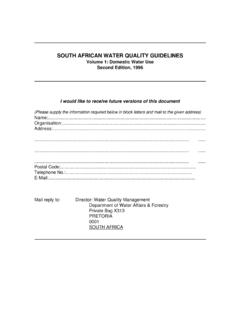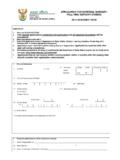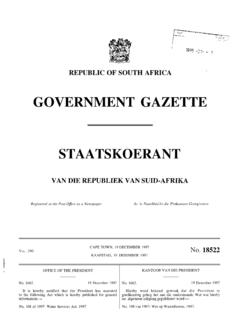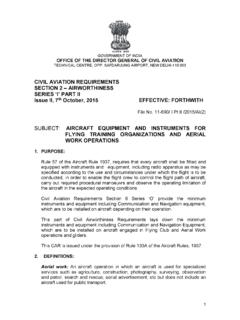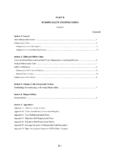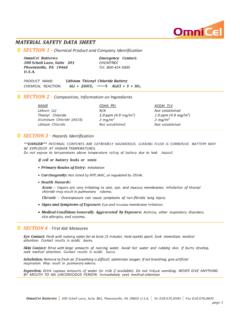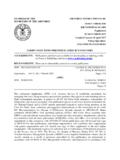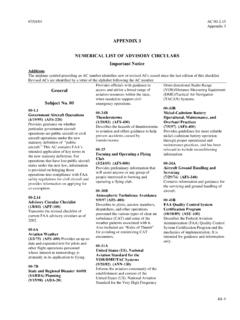Transcription of Section 10 WASTE HANDLING, STORAGE AND …
1 Section 10 WASTE handling , STORAGE AND transportation Introduction The Minimum requirements for WASTE handling , STORAGE and transportations are summarised in Table 10, at the end of this Section . The handling , temporary STORAGE and transpor-tation of Hazardous Wastes follows the same principles and requirements as those, which relate to dangerous goods in general. South Africa accepts the United Nations Recommendations for the transport of Dangerous Goods as incorporated in the International Maritime Organisation's Dangerous Goods Code IMDG and the International Civil Aviation Organisation's Regulations as given in their Technical Notes.
2 These are both implemented as legislation through the Department of Transport's Merchant Shipping Act (Act 57 of 1951) and Aviation Act (Act 72 of 1962). These principles also underlie the regulations relating to the transportation of dangerous goods by rail, as incorporated in Spoornet's Supplement 6 of the Official Tariff Book. Further, they are the basis of a series of SA Bureau of Standards on the transportation of Dangerous Goods by Road currently nearing completion, as well as of forthcoming Standards on handling and STORAGE .
3 It is expected that these Standards will be made law by both the Department of Manpower and the Department of Transport in the future. An additional requirement of the transportation of Hazardous WASTE relates to the "duty of care" principle. This places responsibility for a WASTE on the Generator, and is supported by the "cradle-to-grave" principle, according to which a "manifest" accompanies each load of Hazardous WASTE until it is responsibly and legally disposed of. This manifest is transferred from one transporter to the next along with the load, should more than one transporter be involved.
4 Once the WASTE is properly disposed of at a suitable, permitted facility, a copy of the manifest must be returned to the point of origin. To minimise uncontrolled dumping of Hazardous Wastes, consignors and transporters must comply with the SANS 10406 on transportation of Dangerous Goods. Inter alia, these require an adequate level of training of all personnel involved in the handling and transportation , by both parties. The consignor must satisfy himself of the competence of the carrier and the carrier needs to satisfy himself of the bona fides of the consignor to ensure that materials offered for transport are honestly described and suitably contained and labelled.
5 The objectives of the transportation of Hazardous WASTE are: to ensure the correct packaging, temporary STORAGE and collection of a WASTE prior to transportation , so as to prevent accidental spillage into the environment and minimise the impact should a spillage occur; to ensure that the Hazardous WASTE is never lost : this is achieved by use of a system of documentation or a manifest system; to ensure that the WASTE arrives safely at a permitted facility; to ensure that emergency procedures are in place before an accident occurs, and that the Hazardous WASTE is correctly marked so as to aid the emergency team.
6 It should be noted that all aspects of handling explosive material, flammable material and 94 Minimum requirements for the handling , Classification and Disposal of Hazardous WASTE 10: WASTE handling , STORAGE AND transportation radioactive material are covered by specific legislation. The relevant Acts are the: Explosives Act, 2003 (Act 15 of 2003); Fire Brigade Services Act, 1987 (Act 88 of 1987); and Nuclear Energy Act, 1999 (Act 46 of 1999). Collection and STORAGE A Generator who treats, stores for a period exceeding 90 days, or disposes of Hazardous WASTE on site is subject to Section 20(1) of the Environmental Conservation Act and must apply for a permit for a disposal site from the Competent Authority.
7 Collection It is essential that all WASTE arisings should be accumulated at the point of origin as they occur and that they should not be allowed to lie around for any length of time. Such WASTE material must also not be mixed with other wastes of a different nature or composition. Mixing could result in severe reactions in the case of non-compatible materials and hinder later efforts to recover or recycle the WASTE material. Small additions of a highly toxic or Hazardous WASTE mixed with a less toxic or General WASTE would render both wastes Hazardous and so place an unnecessary (and avoidable) large volume in a higher WASTE category.
8 Once the WASTE has accumulated in a suitable container, the WASTE container itself must be clearly marked before temporary STORAGE to prevent any risk of wrong identification resulting in environmental pollution. Guidance on compatibility of materials is contained in SANS 10232. Temporary STORAGE The migration of leachate or spillage into the ground and groundwater regime around all temporary STORAGE areas must be prevented. A temporary STORAGE site therefore requires a firm waterproof base that is protected from the ingress of storm water from surrounding areas.
9 It must also have an effective drainage system to a water-proof spillage collection area, where any spillage can be recovered and suitably treated. This area must be clearly demarcated and should not be accessible to unauthorised persons. WASTE materials should always be stored separately from other process chemicals or products. If non-compatible wastes are to be stored, care should be taken to adequately separate them, to prevent possible interactions in the event of fire or spillage. Flammable or combustible wastes must in any event be stored separately from other WASTE materials.
10 Quantities of WASTE that can be temporarily accumulated A Generator may accumulate the following quantities of Hazardous WASTE on site for 90 days or less without a permit for a WASTE disposal site: Hazard Rating 1 = 10 kg Hazard Rating 2 = 100 kg Hazard Rating 3 = 1 000 kg Hazard Rating 4 = 10 000 kg provided that: the WASTE is stored in such a manner that no pollution of the environment occurs at any time; the date upon which accumulation begins is clearly marked and visible for inspection on each container; while being stored on site, each container and tank is labelled or marked clearly with the words "Hazardous WASTE "; the Generator fences off the STORAGE area to prevent unauthorised access and erects a weatherproof, durable and clearly legible notice-board in official languages at every entrance of the STORAGE area with the words "Hazardous WASTE : unauthorised entry prohibited".

